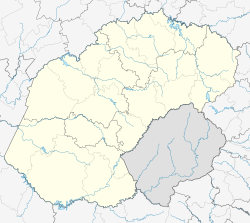Koffiefontein
| Koffiefontein | |
|---|---|
|
|
|
| Coordinates: 29°24′29″S 25°0′8″E / 29.40806°S 25.00222°ECoordinates: 29°24′29″S 25°0′8″E / 29.40806°S 25.00222°E | |
| Country | South Africa |
| Province | Free State |
| District | Xhariep |
| Municipality | Letsemeng |
| Established | 1892 |
| Area | |
| • Total | 36.85 km2 (14.23 sq mi) |
| Population (2011) | |
| • Total | 10,402 |
| • Density | 280/km2 (730/sq mi) |
| Racial makeup (2011) | |
| • Black African | 74.0% |
| • Coloured | 20.4% |
| • Indian/Asian | 0.3% |
| • White | 4.7% |
| • Other | 0.6% |
| First languages (2011) | |
| • Afrikaans | 63.1% |
| • Sotho | 14.2% |
| • Xhosa | 12.1% |
| • Tswana | 7.0% |
| • Other | 3.7% |
| Postal code (street) | 9986 |
| PO box | 9986 |
| Area code | 053 |
Koffiefontein is a small farming town in the Free State province of South Africa. The name means coffee fountain in Afrikaans.
In the 1800s, Koffiefontein was a stopover spot for transport riders traveling between the coast and the diamond fields and gold mines to the north. "Coffee fountain" is a reference to the strong coffee brew transport riders made by during their stopover. "Coffee fountain" involved transport riders grinding their own coffee beans (often with a spoon) and using the water of a natural spring to boil for the brew. Upon the discovery of diamonds near the natural spring in 1870, a town quickly developed at the Koffiefontein stopover spot, as prospectors began to mine the area in search of high quality diamonds.
Koffiefontein's proximity to Mafikeng and Kimberley meant that it became involved in the Second Anglo-Boer War (1899-1902). Blockhouses, which served as defensive fortresses, were erected by the British in 1900 and are still standing in the twenty-first century.
The Koffiefontein district saw lots of military action during the Second Anglo-Boer War of 1899-1902 because it was close to the two strategic towns of Kimberley and Mafeking. After Boer forces under the command of General Brand and Commandant Hertzog attacked the town and its mine, several blockhouses were erected by the British in October 1900. The blockhouses were involved in actions in the subsequent months and at one point the town was looted by the Boers and the people of the town took refuge in the mine.
During the Second World War a large internment camp was opened in the town, with 2000 Italian prisoners of war, some German prisoners of war, and some 800 South African internees, who were suspected of being pro-Nazi. Among the internees was F.C Erasmus and John Vorster who became prime minister of South Africa in 1966 and was president of SA from 1978 to 1979. The remains of murals painted by the Italian POWs can still be viewed in the town as can the barracks in which they were held.
Farming in the district focuses on cattle and sheep farming with lucerne, potatoes and ground nuts being the main crops sown. There used to be a cheese factory and vineyards in the town. The Kalkfontein Dam on the Riet river provides water for the towns of Jacobsdal and Koffiefontein.
...
Wikipedia



